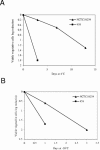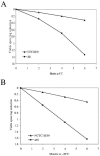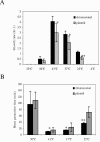Further comparison of temperature effects on growth and survival of Clostridium perfringens type A isolates carrying a chromosomal or plasmid-borne enterotoxin gene
- PMID: 16820444
- PMCID: PMC1489334
- DOI: 10.1128/AEM.00177-06
Further comparison of temperature effects on growth and survival of Clostridium perfringens type A isolates carrying a chromosomal or plasmid-borne enterotoxin gene
Abstract
Clostridium perfringens type A isolates can carry the enterotoxin gene (cpe) on either their chromosome or a plasmid, but food poisoning isolates usually have a chromosomal cpe gene. This linkage between chromosomal cpe isolates and food poisoning has previously been attributed, at least in part, to better high-temperature survival of chromosomal cpe isolates than of plasmid cpe isolates. In the current study we assessed whether vegetative cells and spores of chromosomal cpe isolates also survive better than vegetative cells and spores of plasmid cpe isolates survive when the vegetative cells and spores are subjected to low temperatures. Vegetative cells of chromosomal cpe isolates exhibited about eightfold-higher decimal reduction values (D values) at 4 degrees C and threefold-higher D values at -20 degrees C than vegetative cells of plasmid cpe isolates exhibited. After 6 months of incubation at 4 degrees C and -20 degrees C, the average log reductions in viability for spores of plasmid cpe isolates were about fourfold and about threefold greater, respectively, than the average log reductions in viability for spores from chromosomal cpe isolates. C. perfringens type A isolates carrying a chromosomal cpe gene also grew significantly faster than plasmid cpe isolates grew at 25 degrees C, 37 degrees C, or 43 degrees C. In addition, chromosomal cpe isolates grew at higher maximum and lower minimum temperatures than plasmid cpe isolates grew. Collectively, these results suggest that chromosomal cpe isolates are commonly involved in food poisoning because of their greater resistance to low (as well as high) temperatures for both survival and growth. They also indicate the importance of proper low-temperature storage conditions, as well as heating, for prevention of C. perfringens type A food poisoning.
Figures






Similar articles
-
Comparative effects of osmotic, sodium nitrite-induced, and pH-induced stress on growth and survival of Clostridium perfringens type A isolates carrying chromosomal or plasmid-borne enterotoxin genes.Appl Environ Microbiol. 2006 Dec;72(12):7620-5. doi: 10.1128/AEM.01911-06. Epub 2006 Oct 13. Appl Environ Microbiol. 2006. PMID: 17041163 Free PMC article.
-
Comparative experiments to examine the effects of heating on vegetative cells and spores of Clostridium perfringens isolates carrying plasmid genes versus chromosomal enterotoxin genes.Appl Environ Microbiol. 2000 Aug;66(8):3234-40. doi: 10.1128/AEM.66.8.3234-3240.2000. Appl Environ Microbiol. 2000. Retraction in: Appl Environ Microbiol. 2024 May 21;90(5):e0024924. doi: 10.1128/aem.00249-24. PMID: 10919775 Free PMC article. Retracted.
-
Heat resistance differences are common between both vegetative cells and spores of Clostridium perfringens type F isolates carrying a chromosomal vs plasmid-borne enterotoxin gene.Appl Environ Microbiol. 2024 Oct 23;90(10):e0091424. doi: 10.1128/aem.00914-24. Epub 2024 Sep 18. Appl Environ Microbiol. 2024. PMID: 39291987 Free PMC article.
-
Enterotoxigenic Clostridium perfringens: detection and identification.Microbes Environ. 2012;27(4):343-9. doi: 10.1264/jsme2.me12002. Epub 2012 Apr 14. Microbes Environ. 2012. PMID: 22504431 Free PMC article. Review.
-
Novel insights into the epidemiology of Clostridium perfringens type A food poisoning.Food Microbiol. 2011 Apr;28(2):192-8. doi: 10.1016/j.fm.2010.03.020. Epub 2010 Apr 13. Food Microbiol. 2011. PMID: 21315973 Review.
Cited by
-
Health risk assessment related to waterborne pathogens from the river to the tap.Int J Environ Res Public Health. 2015 Mar 10;12(3):2967-83. doi: 10.3390/ijerph120302967. Int J Environ Res Public Health. 2015. PMID: 25764059 Free PMC article.
-
Pathogenicity and virulence of Clostridium perfringens.Virulence. 2021 Dec;12(1):723-753. doi: 10.1080/21505594.2021.1886777. Virulence. 2021. PMID: 33843463 Free PMC article.
-
Clostridium perfringens Sporulation and Sporulation-Associated Toxin Production.Microbiol Spectr. 2016 Jun;4(3):10.1128/microbiolspec.TBS-0022-2015. doi: 10.1128/microbiolspec.TBS-0022-2015. Microbiol Spectr. 2016. PMID: 27337447 Free PMC article. Review.
-
CodY Promotes Sporulation and Enterotoxin Production by Clostridium perfringens Type A Strain SM101.Infect Immun. 2017 Feb 23;85(3):e00855-16. doi: 10.1128/IAI.00855-16. Print 2017 Mar. Infect Immun. 2017. PMID: 28052992 Free PMC article.
-
Toxigenic Clostridium perfringens Isolated from At-Risk Paediatric Inflammatory Bowel Disease Patients.J Crohns Colitis. 2024 Aug 6;18(7):985-1001. doi: 10.1093/ecco-jcc/jjae016. J Crohns Colitis. 2024. PMID: 38267224 Free PMC article.
References
-
- Andersen, K. G., T. B. Hansen, and S. Knøchel. 2004. Growth of heat-treated enterotoxin-positive Clostridium perfringens and the implications for safe cooling rates. J. Food Prot. 67:83-89. - PubMed
-
- Ando, Y., T. Tsuzuki, H. Sunagawa, and S. Oka. 1985. Heat resistance, spore germination, and enterotoxigenicity of Clostridium perfringens. Microbiol. Immunol. 29:317-326. - PubMed
-
- Brynestad, S., and P. E. Granum. 1999. Evidence that Tn5565, which includes the enterotoxin gene in Clostridium perfringens, can have a circular form which may be a transposition intermediate. FEMS Microbiol. Lett. 170:281-286. - PubMed
-
- Carman, R. J. 1997. Clostridium perfringens in spontaneous and antibiotic-associated diarrhoea of man and other animals. Rev. Med. Microbiol. 8(Suppl. 1):S43-S45.
Publication types
MeSH terms
Substances
LinkOut - more resources
Full Text Sources
Other Literature Sources
Molecular Biology Databases
Research Materials
Miscellaneous

